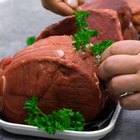AlexPro9500/iStock/GettyImages
The Ratios for Sausage Seasoning Vary, but Not Much
Turning out an occasional batch of homemade sausage is a fun project for any home cook, but there's a big difference between mixing up a few patties of loose sausage and turning out a large quantity of links. When you're working with a pound or two of ground meat, you can add herbs and spices by the pinch until it tastes right – but that's not practical in the 10- or 25-pound batches called for in many recipes. Instead, you'll need to rely on proven recipes, or fine-tune your own using well-established ratios of seasoning to meat.
Salt Is the Key Seasoning
Seasoning for sausage begins with salt, because it's the most fundamental ingredient. Surprisingly, that's less for its flavor than for other reasons. The salt in your sausage changes the texture of its proteins – think of the difference between a ham and a pork roast – and helps the ground-up meat, usually pork, form a smooth mass instead of remaining loose like browned-up crumbles in a skillet. Reaching that texture requires your sausage to have roughly 1.5 to 2 percent salt by weight. Adding salt beyond that ratio is usually, but not always, a matter of taste. Many dried or fermented sausages, like a good salami, have added salt to discourage unwanted microorganisms and keep them food safe. In those sausages, the recommended salt levels should be considered non-negotiable until you're a very experienced sausage-maker indeed.
Curing Salts
If you're ambitious enough to attempt a dried or fermented sausage, you'll need to use a second kind of salt as well, which is sold under various names including Prague powder or tinted curing mix, often abbreviated to TCM. These contain nitrates or nitrites, which help keep the sausage food-safe during its extended curing time. They can be toxic if they're accidentally ingested in too large a quantity, which is why they're often tinted so they're harder to mistake for regular table salt. Most recipes call for them to be weighed on a sensitive scale and then mixed into a larger quantity of ordinary salt. Some products, such as Morton's Tender Quick, simplify matters by premeasuring the correct ratio of salt to curing salt.
Spices and Herbs
Any other seasoning for sausage is determined by tradition, if you're making a specific type of sausage, or by your own palate if you're improvising. Traditional sausages all have distinctive flavor profiles, and omitting signature ingredients such as the fennel seed in Italian sausages or the paprika in Spanish chorizo will rob your sausage of the flavor it's supposed to have. On the other hand, if you're making something less iconic – perhaps you're doing breakfast sausage, and prefer to leave out the nutmeg that's usually included – by all means feel free to please your own taste. Expect to use about a tablespoon of spices per pound of meat for many recipes, but that's only the roughest of guidelines because some herbs and spices are much more potent than others. When in doubt, look up recipes for comparable sausages and see how the flavors are proportioned. Alternatively you can cheat, and buy seasoning mixes already measured for use with a given quantity of meat.
The Nonseasoning: Water
One ingredient you'll see in almost every sausage recipe isn't a seasoning at all, and has zero effect on the flavor. It's water, which is added to give the sausage smoother texture, make it easier to mix and stuff into the casings, and – unsurprisingly – keep the sausage moist. A good rule of thumb is to add about 1 fluid ounce of water per pound of meat, and most recipes fall somewhere close to that figure.
A Few Additional Tips
Most sausages are made from pork, but you can use beef, lamb, turkey, chicken or game if you prefer. One constant, whichever meat you choose, is that fat should make up about 30 percent of your sausage mixture by weight. Without it, your sausages will feel dry and crumbly even if they're properly seasoned otherwise. This is a trap hunters often fall into when making sausage from wild-caught venison or elk, which are lean meats. Because the fat of game animals is strongly and sometimes unpleasantly flavored, recipes usually call for pork fat to make up the difference. Cut it into pieces, and grind it through along with your meat and seasonings for the best results.
Related Articles

How to Make Salt Brine

How to Make Venison Bratwurst
A Saltpeter Substitute for Curing Ham

Types of Portuguese Sausage

How to Smoke Sausage in a Meat Smoker

How to Cook Deer Bologna With a Smoker

How to Make Stuffing Mix Better

Baking Homemade Venison Sausage in a ...

What Is the Difference Between Salt ...

The Best Way to Cook Kielbasa

How to Defrost Bulk Pork Sausage

How Long Do You Smoke Sausage?

How to Make Sausage Links Without Casing

How to Ground Pork

How is Pepperoni Made?

How to Cook Turkey Bratwurst in the Oven
How to Make a Brine for Quail

How to Do Corned Pork

How to Cook Chorizo in the Oven

Uses of Saltpeter in Food
References
Writer Bio
Fred Decker is a trained chef and prolific freelance writer. In previous careers, he sold insurance and mutual funds, and was a longtime retailer. He was educated at Memorial University of Newfoundland and the Northern Alberta Institute of Technology. His articles have appeared on numerous home and garden sites including GoneOutdoors, TheNest and eHow.